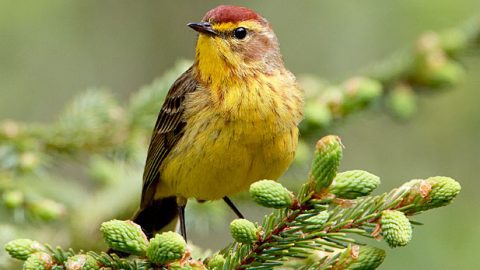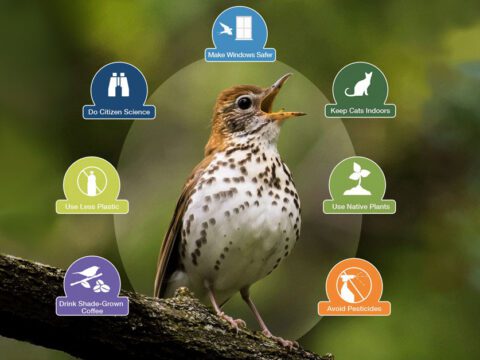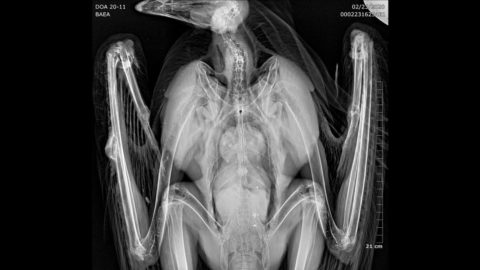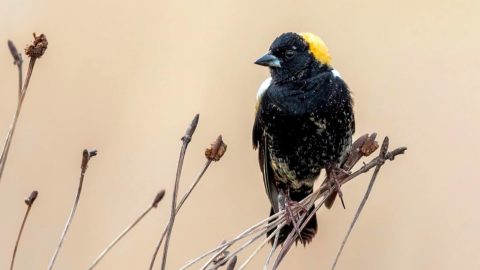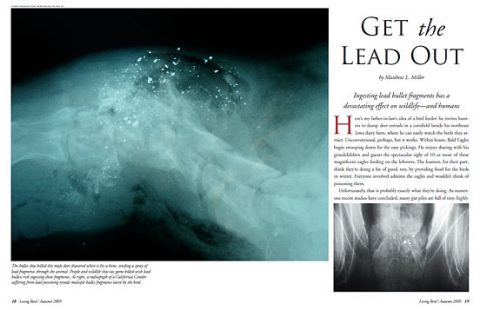Raptors and Rat Poison
July 15, 2015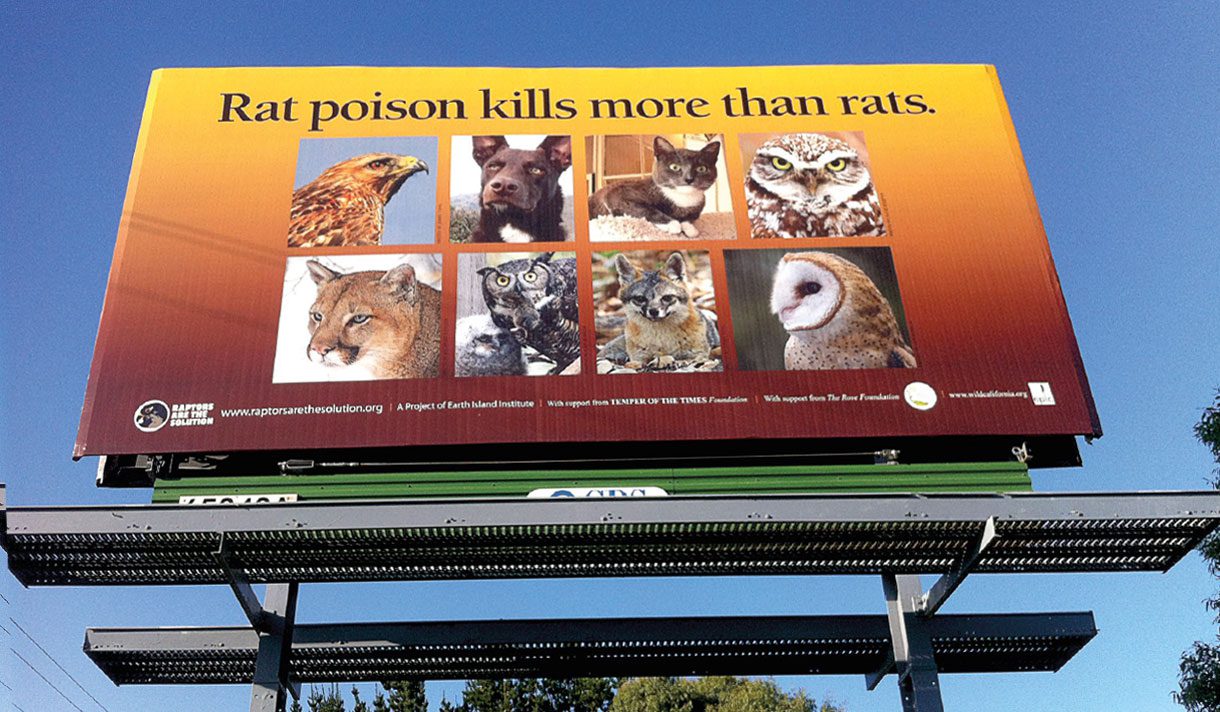
From the Summer 2015 issue of Living Bird magazine.
In Berkeley, California, a juvenile Cooper’s Hawk lay dead in a pool of its own blood on the sidewalk.
Paul Randall and his eight-year-old son Gabe were walking their dog when they discovered the corpse of the bird, which had hatched just two months earlier. The Randalls flagged down their neighbor, Lisa Owens Viani, a volunteer with the Golden Gate Raptor Observatory who keeps tabs on nesting Cooper’s Hawks in the East Bay. Owens Viani had watched this hawk’s parents court each other throughout the late winter. Through a spotting scope, she had observed the two birds bringing twigs to their chosen nest site, high in a tree above the densely packed rooftops of Berkeley. The scope had created a sense of intimacy; she could see individual feathers ruffle in the wind as the hawks took turns incubating their eggs. When the downy white young emerged, Owens Viani watched them beg for food, balancing awkwardly on their oversized feet and stretching their stubby, asyet-unfeathered wings to their sides. Their parents brought them songbirds and small rodents, and they grew fast. Soon the chicks were fully feathered. Clutching the edge of their nest in their talons, they beat their wings, strengthening themselves to fly.
Deadly Poison at a Store Near You
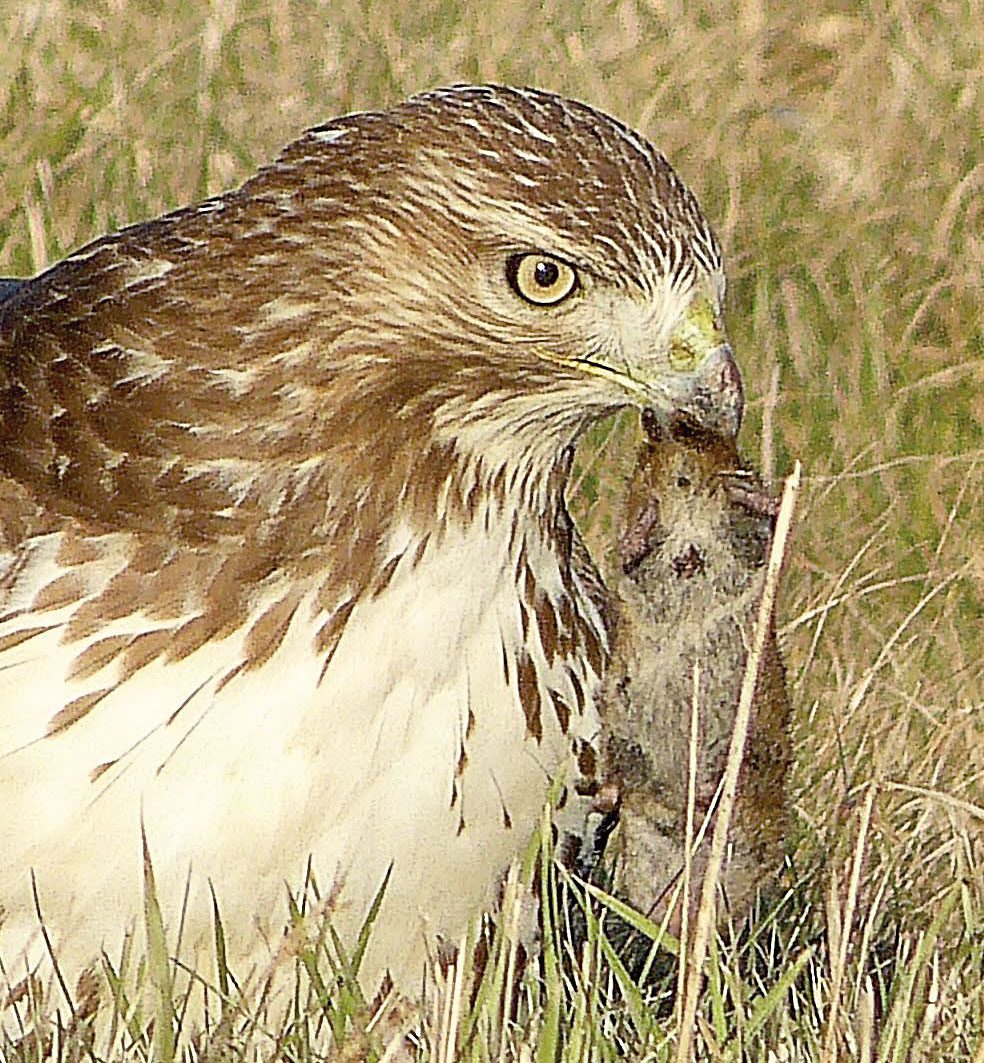
Owens Viani and the Randall family had expected to see the young Cooper’s Hawks fledge and go on their way. They hadn’t expected to find one of the juveniles sprawled dead on the concrete, the victim of a massive hemorrhage.
The culprit behind the gruesome death was a rat poison called brodifacoum, according to tests contracted by WildCare, a Marin County wildlife rehabilitation group. One of a group of killing agents known as second-generation anticoagulant rodenticides, brodifacoum is one of the most widely used rat poisons in America.
The Environmental Protection Agency first moved to limit the use of 10 rodenticide ingredients—including brodifacoum— in 2008, but the regulatory process has crept along slowly due to resistance and litigation from manufacturers. The EPA finally reached an agreement that cut off delivery of products with the regulated rodenticide ingredients to retail outlets as of March 31, 2015. But as part of the legal settlement, stores are allowed to sell out their existing stock. As of May 2015, brightly colored boxes containing these poisons remained on the shelves of many grocery stores, hardware stores, and variety stores. I dispatched family and friends around the country to find out what poisons were still available. My father found brodifacoum-based rodent poisons at a grocery store in Bath, Maine. An old college roommate turned up the same brand at a variety store in Mount Horeb, Wisconsin. A grad-school mentor bought a package of brodifacoum rat bait at a hardware store in Burlington, Vermont. My own secret-shopper expeditions to stores in Southern California didn’t turn up any products containing banned rodenticides, probably because the California Department of Pesticide Regulation prohibited retail sales of second-generation anticoagulants on July 1, 2014.
Brodifacoum will continue to be sold in large tubs by the big chain agricultural supply stores, because the new restrictions have exemptions for bulk sales for agricultural use. There’s nothing illegal about the continued availability of these second-generation anticoagulant poisons. The federal EPA restrictions, it turns out, may not be sufficiently restrictive to substantially lower the risk of accidental poisoning of raptors and other wildlife.
The EPA moved to rein in consumer use of second-generation anticoagulant rodenticides because their potency and delayed action make them particularly dangerous in the case of accidental ingestion by children, pets, and wildlife.
Michael Fry, an environmental toxicologist with the U.S. Fish and Wildlife Service and former director of conservation advocacy for the American Bird Conservancy, has studied the impacts of rat poisons on wildlife since the 1970s. His concern about brodifacoum in particular “is that it is so toxic, and it stays around for so long,” he says. “It has a very long half-life in animals. So if you feed it to a rat, the rat can continue to eat the bait…it builds up way more than a lethal dose in its body.” If an unlucky predator catches the poisoned rat, it may get an easy meal, but it also ingests a huge hit of rodenticide.
The second-generation anticoagulants can also bioaccumulate in an ecosystem in various ways, says Maureen Murray, clinical assistant professor of wildlife medicine at Tufts University’s Cummings School of Veterinary Medicine. “Imagine a squirrel eats some, but not enough to die,” she says. “That squirrel gets eaten by a predator. This happens again and again. These smaller amounts of rodenticide can add up in the predator, accumulating in the individual until it has a lethal dose.”
Or, Murray says, “There’s a bait placed somewhere, and some invertebrates eat it. Then songbirds come along and eat the insects. Then a Cooper’s Hawk comes along and eats the songbird. These are compounds that can move through different steps in the food chain.”
But pinning down a rodenticide as the cause of death for hawks, eagles, falcons, and owls is challenging. “It’s tough to say for sure [how many birds are affected],” says Allen Fish, director of the Golden Gate Raptor Observatory in California. “Diagnosis is expensive, $100 to $200 per bird. A lot of wildlife rehabilitation organizations can’t afford that kind of expense.”
The high mobility of raptors further complicates attempts to pinpoint cause and effect. Second-generation rodenticides used for prairie dog control on the Great Plains, for example, may end up in the liver tissues of hawks or eagles that travel long distances. As Fry points out, “If these birds are feeding on poisoned prairie dogs, it’s a foregone conclusion that they will die. But it takes 5 to 10 days. They could be hundreds of miles away by then, if they’re on migration.”
To try to assess the prevalence of rodenticide toxicosis in raptors, veterinarian Murray published a study examining Massachusetts Red-tailed Hawks, Barred Owls, Eastern Screech-Owls, and Great Horned Owls that had been admitted to the Tufts Wildlife Clinic between 2006 and 2010. Of 161 birds, 139—a whopping 86 percent—tested positive for anticoagulant rodenticides. Ninety-nine percent of those had brodifacoum in their liver tissues. Yet only nine of these birds displayed sufficient symptoms to lead to a clinical diagnosis of anticoagulant rodenticide poisoning. “The birds that we get in that are clinically showing signs are a very small percentage of the number that are actually affected,” explains Murray. “For us to get a bird, someone has to find it, pick it up, and bring it in. With these rodenticides, it takes a few days for the bird to die—for them to lose so much blood that they can’t fly off.
“But before that, the bird starts feeling unwell. It may hunker down in its roost and not move. It’s possible that a lot of these birds are dying unnoticed.”
Indeed, it may well be that the proximate cause of death of a poisoned raptor is something other than the poison. Imagine a sick hawk that is slow to get out of the way of an oncoming car. Or take the case that Lisa Owens Viani describes of a hatch-year Cooper’s Hawk “killed by a kitten” in her neighborhood in August 2013. Suspecting that there was no way a young cat should have been able to take down even a recently fledged hawk, Owens Viani packed the bird’s body on ice and sent it to the California Department of Fish and Wildlife for examination by a wildlife pathologist. She says the report came back saying that the cause of death was a puncture wound to the breast, but that brodifacoum and bromodialone were both found in the hawk’s liver tissue. Would the cat have been able to kill this bird if it hadn’t been exposed to anticoagulants? There is no way to know.
A knowledge gap, says Allen Fish, is precisely the trouble. “There’s no clear public record of where we’re putting pesticides, who’s using them, how much is being used. Until we demand that information, we’re flying blind. There needs to be a whole public reckoning of who uses what, and why. We need to track how operators are using [pesticides] and then see if there’s any correlation with animal kills. We don’t know these impacts. We don’t have any data.”
Cynthia Palmer, director of pesticides science and regulation at the American Bird Conservancy, agrees: “I fear that there won’t be enough information to accurately assess the impacts since [the EPA doesn’t] have information on sales at the retail or wholesale levels, and their incident reporting system is quite weak and in desperate need of reform. The reporting thresholds are absurdly high for dead wildlife, 5 raptors, 50 songbirds, or 200 ‘flocking’ birds. Four dead hawks…does not meet the reporting requirement.”
A “Simple” Solution with Tragic Consequences
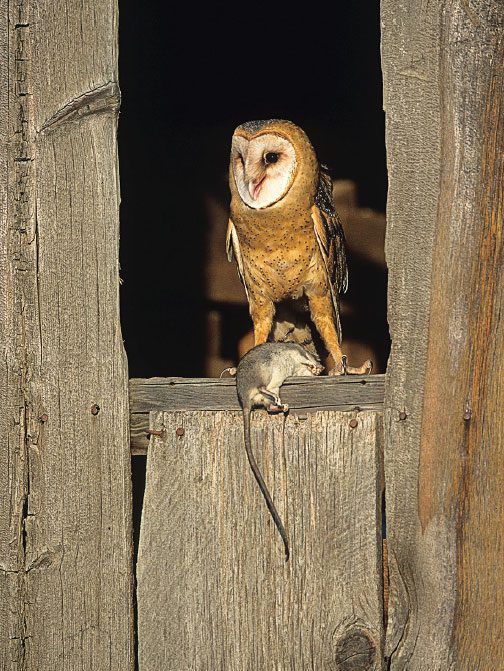
Rodent baits containing brodifacoum or similar compounds have been marketed to squeamish consumers as a “simple, mess-free solution.” “You don’t have to come in contact with mice to eliminate them from your home,” reads the advertising copy for one product, “because mice take the bait and then leave to die, all you have to do is set the bait and let [it] do the rest.”
Poison baits containing second-generation anticoagulants sound like the perfect solution to those hair-raising skritching noises in the walls at night. “You have a rat problem. You want to kill the rat, but you don’t want it to die in your house. So it was brilliant logic for these companies to develop a poison that causes the rats to get really thirsty and follow their instinct to go outside to get water,” says Fish. “The problem is, there’s an owl out there. It’s hungry. It’s looking around, scanning for prey, and it sees this rat staggering around. Of course it’s going to eat it.”
Infestations of rats and mice have plagued human settlements for millennia, but our efforts at rodent control haven’t always had the far-reaching impacts on wildlife that we see today. Historically, people with rat problems set out baits laced with substances such as arsenic or strychnine. These poisons are very good at killing rats—too good, in fact. Because they are acutely toxic and act fast, a rat that feeds on arsenic-tainted bait will keel over on the spot. The corpse warns off other rats, and the rodent problem remains a problem.
The solution lay in a slower-acting rat poison. In the 1940s, warfarin became a widely used anticoagulant rodenticide that made it much easier to kill pesky rats. Because of the delay between consumption of a lethal dose and death, the rat could feed on poisoned bait and then scurry about its business, dying of internal bleeding somewhere else a few days later. Without a telltale carcass alongside the bait, other rats did not sense any danger and fed freely on the poison.
Warfarin and the other early anticoagulants have waned in popularity over the decades, though, because the effects of warfarin are chronic, meaning a rodent must feed on poisoned bait several times over the course of about a week. A single dose is usually not enough to kill. Plus, rats and mice can develop resistance to warfarin if the compound is used in one place over a long period.
The second-generation anticoagulant rodenticides solved these problems by acting like a beefed-up, re-engineered warfarin. A single feeding on brodifacoum bait is often enough to kill a rat, but the dying process still takes days. During this time, the doomed, disoriented, and desperate rat makes an easy meal for a hawk.
Related Stories
If the hawk ingests enough poison, it too faces a grisly death. Its internal organs become puddled with blood that just won’t clot. It bleeds out of its mouth. Some hawks, says Fish, have drowned in backyard swimming pools as they try to satisfy their unquenchable thirst.
Raptors will continue to die from second-generation anticoagulant rodenticides despite the EPA’s new controls. Even after online retailers and corner hardware stores have sold the last bait from their existing stock, the second-generation rodenticides will still be sold in bulk at agricultural supply stores.
The EPA’s 2008 decision to restrict consumer access allowed manufacturers three years to comply with new regulations that would “minimize children’s exposure to rodenticide products used in homes” and “reduce wildlife exposures and ecological risks.” To accomplish these goals, the EPA set out two categories of new restrictions. First, the agency required that rodenticides be sold only in a block or paste inside an approved bait station. Making it harder to scatter lethal bait pellets across the basement floor should cut down on accidental poisonings of children and dogs, but may do little to affect indirect transmission of rodenticides to wildlife. That’s where the EPA’s second restriction comes in, the requirement that “general consumers” be limited from directly purchasing second-generation anticoagulants.
“It’s really good news how it’s turned out, in that at least we’ve gotten the second-generation rodenticides out of the Walmarts and K-Marts where so many people go,” says American Bird Conservancy’s Palmer. “That was a victory for eagles, owls, hawks, and other wildlife, and obviously children and pets as well. But there’s a ways to go. We want to close the loopholes that still exist.”
One of the largest loopholes is the agricultural exemption. In 2007, the EPA proposed restricting the agricultural use of secondgeneration anticoagulants. But the agency’s 2008 Risk Mitigation Decision states that their proposal was met by an outcry from “poultry and livestock producer groups indicating that the proposed requirement would [constitute] a significant burden.” Based on those comments, the EPA concluded that “the benefits of the use of second-generation anticoagulants by poultry and livestock producers outweigh the risks.”
“Even if there are cases where some contained use of rat poison may be justified,” says Fish, “it surely isn’t as many cases as where the stuff is used now.” Until more data are available on where rodenticides are used and how many wild animals are affected, there is no way to know what constitutes a justifiable use.
For that reason, says Palmer, ABC would like to see the whole reporting system revamped. “It’s so rare to find animal kills that even a single death can be the canary in the coal mine. If more deaths were investigated, they could give tremendously useful information about the impact on wildlife and people. And then make this information public so that we can actually use the data to make changes for the better.”

Pest Control Options Save Lives
After finding several raptor carcasses in her Berkeley neighborhood, Lisa Owens Viani turned activist. Appalled at the slow pace of the regulatory process, she decided to see if grassroots action would yield better results. In 2011 she co-founded a coalition called Raptors Are The Solution (RATS) that seeks to educate the public about the ecological dangers of rat poisons. From the start, the organization’s key message was that birds of prey are a fantastic, all-natural form of rodent control. “Lots of people have an appreciation for and an interest in birds of prey,” Owens Viani remarks.
At about the same time, the city of San Francisco was working on the rodenticide issue in response to wildlife poisonings in Golden Gate Park. While waiting for the implementation of the EPA’s 2008 ruling, the city sent out letters to businesses requesting that they stop selling second-generation anticoagulants. Although this was simply a voluntary measure, “they’ve had some really good compliance,” says Owens Viani. In fairly short order, “about thirty businesses…responded saying they’ve taken the stuff off their shelves.”
Following San Francisco’s lead, RATS soon succeeded in getting the city councils of nearby Berkeley, Albany, and Richmond to pass resolutions along the same lines. By spring 2015, 22 cities in California had taken similar steps.
To commend businesses that stop selling and organizations that stop using rat poisons, RATS started the Owl Wise Leaders award program. Recipients of the 35 OWL awards so far include stores, restaurants, Marin County, the San Francisco Recreation and Parks’ Natural Areas Program, and Pepperdine University.
As for the environmentally conscious homeowner with a rodent problem, Palmer points out that “there are many effective, economical, and easy-to-use pest control options that are much better for human health and for wildlife.” (ABC offers a list at saferodentcontrol.org.)
According to Fish, snap traps offer a more humane way to kill rats than a drawn-out and painful death by poison: “Snap-traps are fast and efficient, and have the wonderful added benefit that no raptor is going to come along and eat the rat and get killed.
“But if you could create the perfect rodent trap for your suburban backyard, it’d look like a hawk.”

All About Birds
is a free resource
Available for everyone,
funded by donors like you
American Kestrel by Blair Dudeck / Macaulay Library
